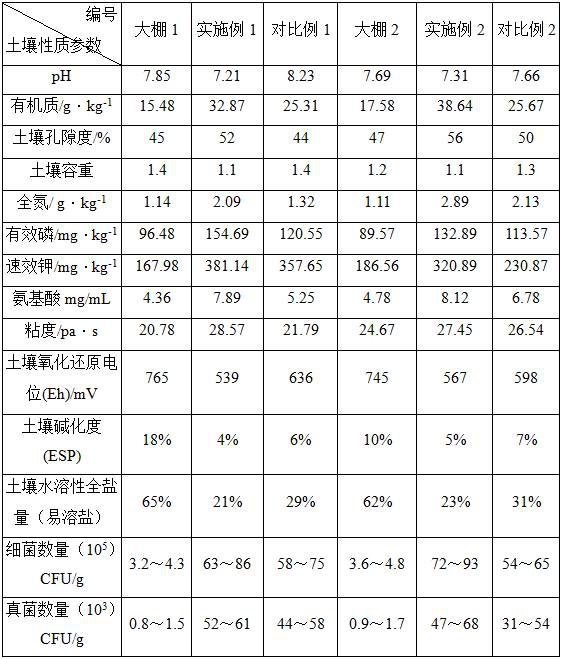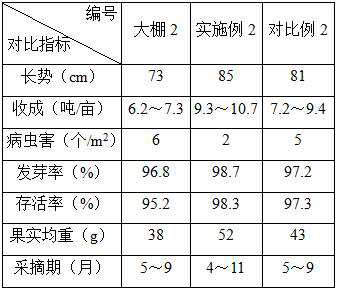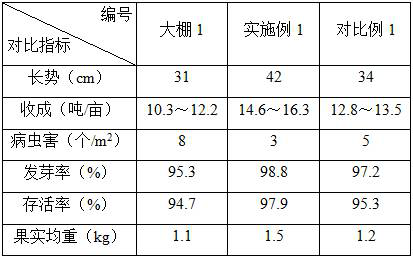Rapid ecological restoration method for facility greenhouse soil
An ecological restoration and facility technology, applied in the fields of land preparation methods, soil conditioning materials, chemical instruments and methods, etc., can solve the problems of soil water retention, fertilizer retention capacity reduction, aerobic microorganism activity decline, soil salt accumulation nitrate and other problems, Achieve the effect of inhibiting soil harmful microorganisms, increasing production and income, and improving soil structure
- Summary
- Abstract
- Description
- Claims
- Application Information
AI Technical Summary
Problems solved by technology
Method used
Image
Examples
preparation example Construction
[0055] Reference example 1 of the preparation method of mixed fermentation material
[0056] After the liquor discarded grains, the straw decomposing agent and the sugar-making waste liquor are mixed in a mass ratio of 100:10:1, and then fermented at 37° C. for 15 days, it is finished.
Embodiment 1
[0058] The facility greenhouse of this embodiment is located in Yula Village, Duoba Town, Huangzhong District, Xining City, Qinghai Province, with an area of 50 mu, and has been cultivating zucchini crops for 5 years, which is recorded as greenhouse 1.
[0059] (1) On May 1st, 40cm of soil in the facility greenhouse was shallowly turned, and after being exposed to the sun for 7 days, the land was irrigated with yellow water at an application rate of 3200kg / mu;
[0060] (2) On May 15th, the mixed fermentation product of discarded liquor lees, straw decomposing agent and sugar-making waste liquid obtained in Reference Example 1 was spread evenly on the soil surface of the facility greenhouse at an application rate of 2.5t / mu, and the soil was deeply plowed. 70cm, continuous sun exposure for 7d;
[0061] (3) On June 15th, the biochar was evenly spread on the soil surface of the facility greenhouse at an application rate of 300kg / mu, and the soil was irrigated with yellow water ...
Embodiment 2
[0067] The facility greenhouse of this embodiment is located on Yanhua Road, Dujiangyan City, Chengdu, with an area of 20 mu, and has been cultivated for 3 years of pepper crops, which is recorded as greenhouse 2.
[0068] (1) On May 1st, 30cm of soil in the greenhouse of the facility was shallowly turned, and after being exposed to the sun for 6 days, the land was irrigated with yellow water at an application rate of 3000kg / mu;
[0069] (2) On May 12, the mixed fermented product of the discarded liquor grains, straw decomposing agent and sugar-making waste liquid obtained in Reference Example 1 was spread evenly on the soil surface of the facility greenhouse at an application rate of 2.0t / mu, and the soil was deeply plowed. 80cm, continuous sun exposure for 6d;
[0070] (3) On June 14th, the biochar was evenly spread on the soil surface of the facility greenhouse at an application rate of 280kg / mu, and the soil was irrigated with yellow water at an application rate of 1200k...
PUM
| Property | Measurement | Unit |
|---|---|---|
| depth | aaaaa | aaaaa |
| depth | aaaaa | aaaaa |
| depth | aaaaa | aaaaa |
Abstract
Description
Claims
Application Information
 Login to View More
Login to View More - R&D
- Intellectual Property
- Life Sciences
- Materials
- Tech Scout
- Unparalleled Data Quality
- Higher Quality Content
- 60% Fewer Hallucinations
Browse by: Latest US Patents, China's latest patents, Technical Efficacy Thesaurus, Application Domain, Technology Topic, Popular Technical Reports.
© 2025 PatSnap. All rights reserved.Legal|Privacy policy|Modern Slavery Act Transparency Statement|Sitemap|About US| Contact US: help@patsnap.com



